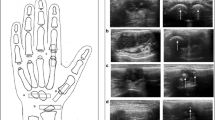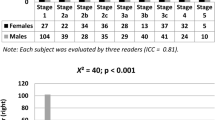Abstract
Objective
To test whether the conventional radiographic technique in determining bone age abnormalities can be replaced by ultrasonography.
Materials and Methods
A total of 54 Caucasian subjects up to 7 years of age with clinically suspected growth problems underwent left hand and wrist radiographic and ultrasonographic bone age estimations with the use of the Greulich-Pyle atlas. The ultrasonographic scans targeted the ossification centers in the radius and ulna distal epiphysis, carpal bones, epiphyses of the first and third metacarpals, and epiphysis of the middle phalanx, as described in previous reports. The degree of agreement between the two sets of data, as well as the accuracy of the ultrasonographic method in detecting radiographically suggested bone age abnormities, was examined.
Results
The mean chronological age, radiographic bone age, and ultrasonographic bone age (all in months) were 41.96 ± 22.25, 26.68 ± 14.08, and 26.71 ± 13.50 in 28 boys and 43.62 ± 24.63, 30.12 ± 17.69, and 31.27 ± 18.06 in 26 girls, respectively. According to the Bland-Altman plot there was high agreement between the results of the two methods with only three outliers. The deviations in bone age from the chronological age taken by the two techniques had the same sign in all patients. Supposing radiography to be the method of reference, the sensitivity, specificity, positive predictive value, and negative predictive value of sonography in detecting growth abnormalities were all 100 % in males and 90.9, 100, 100, and 93.8 %, respectively, in females.
Conclusion
The conventional radiographic technique for determining bone age abnormalities could be replaced by ultrasonography.



Similar content being viewed by others
References
Mentzel HJ, Vilser C, Eulenstein M, Schwartz T, Vogt S, Bottcher J, et al. Assessment of skeletal age at the wrist in children with a new ultrasound device. Pediatr Radiol. 2005;35(4):429–33.
Daneff M, Casalis C, Bruno CH, Bruno DA. Bone age assessment with conventional ultrasonography in healthy infants from 1 to 24 months of age. Pediatr Radiol. 2015.
Castriota-Scanderbeg A, Sacco MC, Emberti-Gialloreti L, Fraracci L. Skeletal age assessment in children and young adults: comparison between a newly developed sonographic method and conventional methods. Skelet Radiol. 1998;27(5):271–7.
Wagner UA, Diedrich V, Schmitt O. Determination of skeletal maturity by ultrasound: a preliminary report. Skelet Radiol. 1995;24(6):417–20.
Nessi R, Garattini G, Bazzini E, Zaffaroni R, Lazzerini F. [Ultrasonography assessment of ossification foci of the wrist and pubertal growth spurt]. La Radiol Med. 1997;94(1–2):43–6.
Bilgili Y, Hizel S, Kara SA, Sanli C, Erdal HH, Altinok D. Accuracy of skeletal age assessment in children from birth to 6 years of age with the ultrasonographic version of the Greulich-Pyle atlas. J Ultrasound Med. 2003;22(7):683–90.
Khan KM, Miller BS, Hoggard E, Somani A, Sarafoglou K. Application of ultrasound for bone age estimation in clinical practice. J Pediatr. 2009;154(2):243–7.
Greulich WW, Pyle SI. Radiographic atlas of skeletal development of the hand and wrist. 2nd ed. Stanford: Stanford University Press; 1959.
van Rijn RR, Lequin MH, Robben SG, Hop WC, van Kuijk C. Is the Greulich and Pyle atlas still valid for Dutch Caucasian children today? Pediatr Radiol. 2001;31(10):748–52.
Horter MJ, Friesen S, Wacker S, Vogt B, Leidiger B, Roedl R, et al. [Determination of skeletal age : comparison of the methods of Greulich and Pyle and Tanner and Whitehouse]. Orthopade. 2012;41(12):966–76.
Kreitner KF, Schweden FJ, Riepert T, Nafe B, Thelen M. Bone age determination based on the study of the medial extremity of the clavicle. Eur Radiol. 1998;8(7):1116–22.
Khan KM, Sarafoglou K, Somani A, Frohnert B, Miller BS. Can ultrasound be used to estimate bone mineral density in children with growth problems? Acta Paediatr. 2013;102(9):e407–12.
Koc A, Karaoglanoglu M, Erdogan M, Kosecik M, Cesur Y. Assessment of bone ages: is the Greulich-Pyle method sufficient for Turkish boys? Pediatr Int. 2001;43(6):662–5.
Buken B, Safak AA, Yazici B, Buken E, Mayda AS. Is the assessment of bone age by the Greulich-Pyle method reliable at forensic age estimation for Turkish children? Forensic Sci Int. 2007;173(2–3):146–53.
Patil ST, Parchand MP, Meshram MM, Kamdi NY. Applicability of Greulich and Pyle skeletal age standards to Indian children. Forensic Sci Int. 2012;216(1–3):200 e201–204.
Hackman L, Black S. The reliability of the Greulich and Pyle atlas when applied to a modern Scottish population. J Forensic Sci. 2013;58(1):114–9.
Zhang A, Sayre JW, Vachon L, Liu BJ, Huang HK. Racial differences in growth patterns of children assessed on the basis of bone age. Radiology. 2009;250(1):228–35.
Moradi M, Sirous M, Morovatti P. The reliability of skeletal age determination in an Iranian sample using Greulich and Pyle method. Forensic Sci Int. 2012;223(1–3):372 e371–374.
Zabet D, Rerolle C, Pucheux J, Telmon N, Saint-Martin P. Can the Greulich and Pyle method be used on French contemporary individuals? Int J Legal Med. 2015;129(1):171–7.
Mansourvar M, Ismail MA, Raj RG, Kareem SA, Aik S, Gunalan R, et al. The applicability of Greulich and Pyle atlas to assess skeletal age for four ethnic groups. J Forensic Leg Med. 2014;22:26–9.
Altman DG, Bland JM. Measurement in medicine: the analysis of method comparison studies. Statistician. 1983;32(3):307.
Carpenter CT, Lester EL. Skeletal age determination in young children: analysis of three regions of the hand/wrist film. J Pediatr Orthop. 1993;13(1):76–9.
Conflict of interest
The authors declare that they have no conflict of interest.
Author information
Authors and Affiliations
Corresponding author
Rights and permissions
About this article
Cite this article
Hajalioghli, P., Tarzamni, M.K., Arami, S. et al. The utility of ultrasonographic bone age determination in detecting growth disturbances; a comparative study with the conventional radiographic technique. Skeletal Radiol 44, 1351–1356 (2015). https://doi.org/10.1007/s00256-015-2175-8
Received:
Revised:
Accepted:
Published:
Issue Date:
DOI: https://doi.org/10.1007/s00256-015-2175-8




